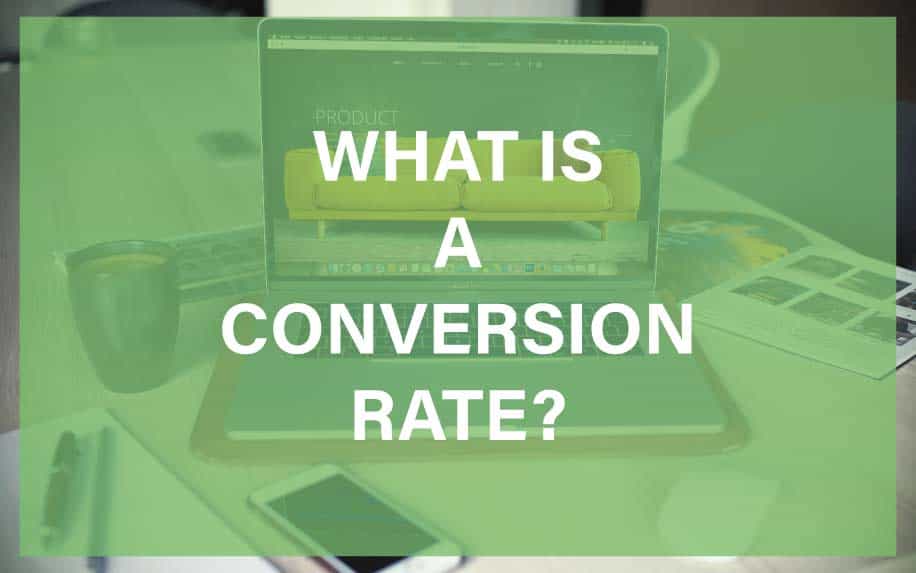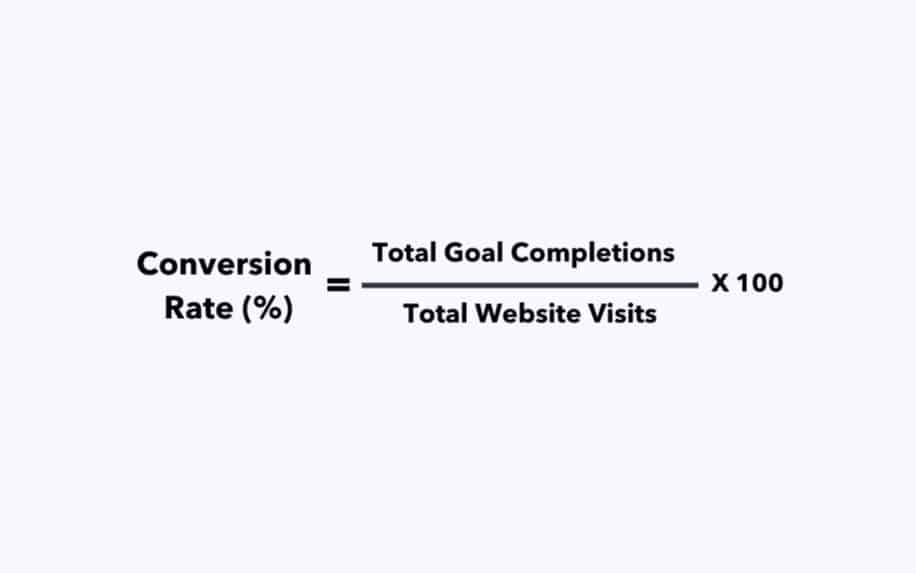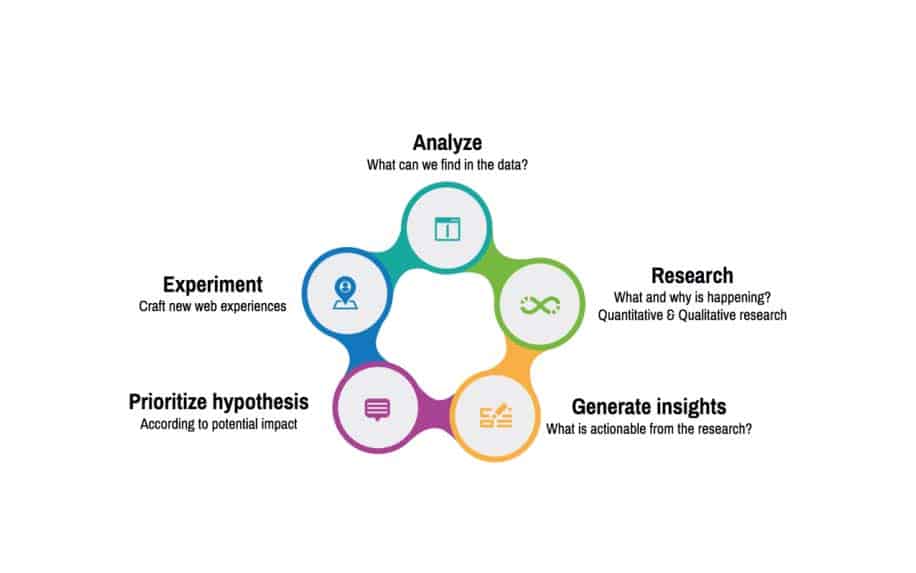What is a conversion rate? In the business world, it’s all about sales which must mean it’s all about conversion too. Conversions are how your website ultimately makes money, either through making sales or getting users into your marketing funnel.
One of the best ways to measure the success of a product, service marketing approach or just about anything else is by using a conversion rate.
Understanding conversion rates makes it possible to implement new marketing techniques while optimising these methods to make the most of your marketing spend.
Let’s start with the basics.
Table of Contents
What is a Website’s Conversion Rate?
The term “conversion rate” can mean a number of things to different people. However, normally a conversion rate is the percentage of individuals who take a desired action.

The most common example of a conversion rate is a percentage of website visitors who end up purchasing a product or service from the website.
At other times, a conversion doesn’t need to occur when a website visitor makes a purchase. There are other Key Performance Indicator (KPI) opportunities that a business can use to measure other conversion rate forms.
Types of Conversion
While buying something is the most common kind of conversion, and indeed the most valuable, there are a number of other actions which users can take on your site:
- Signing up for a service,
- Contacting your business,
- Entering in an email address to join a mailing list,
- Becoming a registered user,
- Downloading trial software,
- Upgrading to a new service level,
- Downloading an application on a mobile device.
In other words, a conversion rate meaning is determined by the action you want people to take on your site.
A company identifies a set outcome goal. This could be making sales or increasing a social media following.
Every user who interacts with a marketing campaign becomes a visitor and every one of these visitors who obtains the final goal set out by the company becomes a conversion.
Conversion rate optimization (CRO) is the process of improving the percentage of website visitors who take a desired action, such as making a purchase, signing up for a newsletter, or downloading a whitepaper. A business’s conversion rate is the percentage of visitors who complete a desired action divided by the total number of visitors. For example, if a website has 100 visitors and 10 of those visitors make a purchase, the conversion rate is 10%.
Conversion goals can vary depending on the type of business, but some common examples include:
- E-commerce: Making a purchase
- Lead generation: Signing up for a newsletter or completing a contact form
- Content marketing: Downloading a whitepaper, webinar, or other asset
- social media: Following the brand on social media or liking/sharing a post
- App downloads: Downloading and installing a mobile app
Here are some examples of how businesses can use conversion rate optimization to achieve their goals:
- E-commerce: A clothing store can improve its conversion rate by making it easier to browse products, simplifying the checkout process, and offering free shipping on orders over a certain amount.
- Lead generation: A business can improve its conversion rate by creating more valuable and relevant content, targeting specific audiences with their marketing campaigns, and optimizing their website for lead capture.
- Content marketing: A SaaS company can improve its conversion rate by creating more engaging and informative blog posts, offering free trials of their software, and running webinars and demos.
- Social media: A restaurant can improve its conversion rate by running contests and giveaways, posting high-quality images of its food, and responding to customer comments and questions promptly.
- App downloads: A mobile game developer can improve its conversion rate by offering free trials, running in-app promotions, and optimizing the app’s store listing.
By implementing effective CRO strategies, businesses can increase their website traffic, improve customer engagement, and boost their bottom line.
Here is a table that summarizes the key concepts of conversion rate optimization:
| Concept | Definition | Example |
|---|---|---|
| Conversion rate | The percentage of visitors who complete a desired action | 10% of website visitors make a purchase |
| Conversion goal | The specific action that a business wants visitors to take | Make a purchase, sign up for a newsletter, download a whitepaper |
| Conversion funnel | The steps that a visitor takes to complete a desired action | Visitor arrives on website, browses products, adds items to cart, completes checkout |
| A/B testing | A method of comparing two versions of a website or marketing campaign to see which one performs better | Comparing two different landing pages to see which one generates more leads |
| User experience (UX) | The overall experience that a user has when using a website or product | Making sure that the website is easy to navigate and use |
| Data-driven decision-making | Using data to make informed decisions about website design, marketing campaigns, and other aspects of the business | Using analytics to identify which pages are performing well and which ones need to be improved |
How to Calculate a Conversion Rate
Calculating a conversion rate is rather straightforward.
First, you need to know how many people have visited your site, either in total or from a single marketing channel.
Next, identify the number of successful “conversions” your site had, such as the number of sales, the number of individuals who signed up for an email newsletter or whatever else the end goal for the marketing plan was.
Divide the number of conversions by the total number of interactions. This is your conversion rate.

What is Conversion Rate Optimisation?
The drive of any business is to reach its desired goals with the highest conversion rate possible.
While a 100 percent conversion rate is not likely, there are ways to boost the current conversion rate, through a process known as conversion rate optimization (CRO). This is the method of which the desired outcome is increased.
There are a number of different CRO methods.
In many instances, tips and tools used to improve the conversion rate will also boost other performance features on a website, such as search engine optimization and bounce rate.
One method for boosting the CRO is to reduce website load time.
The longer it takes a website to load the higher the likelihood of a visitor leaving the site. Website load time also impacts a site’s search engine optimization as search engines such as Google take into account load time when determining site ranks.
A reduction in load time will also help improve the bounce rate, decreasing the proportion of users who immediately exit the site.
Content and Conversion Rate Optimization
Another way to boost CRO is to increase the level of content. By adding more blog posts to a site during a given week, it’s possible to increase website exposure. This promotes the business further and allows visitors to increase interaction with the business.
These posts also help boost the number of times a search engine crawls the site, which helps with search engine optimization as well.
A few other ways a website, business owner or marketing agency can boost the conversion rate is to add social sharing options to a website.
This positions important content for a website above the fold and by focusing on a single topic when creating advertisement material.
By implementing these different tips, it’s possible for a website, business owner or marketer to improve the company’s overall conversion rate.
CRO and Web Design
There are also a number of web design elements which will help to boost your conversion rate. These include things like providing simplistic and easy navigation towards your key conversion points.
You can also experiment with different language and colour combinations on your calls to action, in order to choose the design which resonates the best with your users.

Monitoring Conversions on Your Site
While the standard conversion rate is the number of conversions divided by the number of unique interactions, there are other conversion rate monitoring methods that you should be aware of.
Some services, such as Google AdWords, help by automatically providing this information within a user’s dashboard. However, there may be times when the business wants to know how to perform the formula on their own.
For example, you’ll want to know which marketing channels or landing pages offer the best conversions, as well as how many site visits are required for the average user to make a purchase.
Outside of the standard conversion rate formula, the cost per conversion is important to know as well. This builds slightly on the standard formula. The cost per conversion begins with identifying the cost per click.
This is the amount of money a business spends bringing in a visitor to the website. Often, this is done by a CPC advertisement.
Conversion Cost Explained
Every time someone clicks on the advertisement the business is charged an advertising fee. Sometimes this fee will vary based on the current rate for which Google charges based on the keyword.
To begin the formula, it’s necessary to identify the current cost per click.
From here, the user needs to multiply the cost per click by the number of clicks. If, for example, the cost per click is £0.50 and 1,000 users clicked on the advertisement, it cost the company a total of £500 to generate the conversions.
If the business saw a total of 25 conversions, it’s then necessary to divide 25 by 500, which is 20 (or £20). In this instance, it costs the company £20 per conversion.
Your website’s conversion rate is one of the most important data points you have to decide if your online efforts are effective. Ultimately, this figure tells you how effective your website is as a sales tool.
By understanding a conversion rate, it becomes that much easier to identify ways to improve what the business does.
From conversion rate optimization to taking advantage of Google AdWords, there’s a considerable amount of knowledge any marketing professional or business owner can take from the conversion rate statistic.
The latest conversion rate benchmark statistics by industry:
Industry | Average Conversion Rate —|—|—| E-commerce | 2.35% | Retail | 1.80% | Hospitality | 2.20% | Financial Services | 2.70% | Travel | 3.20% | Education | 3.10% | Healthcare | 3.00% | Real Estate | 1.50% | Technology | 2.60% | Manufacturing | 2.10% |
These statistics are based on data from a variety of sources, including eMarketer, Invespcro, and Adobe. It is important to note that these are just averages, and your actual conversion rate may vary depending on a number of factors, such as your website design, marketing campaigns, and target audience.
Here are some additional insights into conversion rates by industry:
- E-commerce: Conversion rates in the e-commerce industry have been trending upwards for several years, thanks in part to the continued growth of mobile shopping and advancements in personalization technology. However, conversion rates still vary widely by industry, with apparel and footwear retailers typically having higher conversion rates than electronics or home goods retailers.
- Retail: Conversion rates in the retail industry have been relatively flat in recent years, as consumers have become more accustomed to shopping online. However, there is still a significant opportunity for retailers to improve their conversion rates by optimizing their websites for mobile shoppers and offering convenient checkout options.
- Hospitality: Conversion rates in the hospitality industry have been slowly recovering since the pandemic, but they are still below pre-pandemic levels. Hotels can improve their conversion rates by offering competitive rates, providing excellent customer service, and making it easy for guests to book rooms online.
- Financial Services: Conversion rates in the financial services industry have been increasing in recent years, as more consumers are using online banking and financial planning tools. However, conversion rates still vary widely by product, with credit cards and mortgages typically having higher conversion rates than savings accounts or insurance policies.
- Travel: Conversion rates in the travel industry have been rebounding since the pandemic, as consumers are eager to travel again. Airlines and hotels can improve their conversion rates by offering flexible booking options, providing clear and concise pricing information, and offering personalized travel recommendations.
- Education: Conversion rates in the education industry have been increasing in recent years, as more students are taking online courses. Educational institutions can improve their conversion rates by offering high-quality online courses, providing strong student support, and making it easy for students to enroll in courses.
- Healthcare: Conversion rates in the healthcare industry have been increasing in recent years, as more patients are using online scheduling and telehealth services. Healthcare providers can improve their conversion rates by making it easy for patients to find and book appointments online, providing clear and concise information about their services, and offering personalized care plans.
- Real Estate: Conversion rates in the real estate industry have been relatively flat in recent years, as consumers have become more cautious about making large purchases. Real estate agents can improve their conversion rates by providing excellent customer service, building strong relationships with potential clients, and using effective marketing strategies.
- Technology: Conversion rates in the technology industry have been increasing in recent years, as more consumers are purchasing technology products online. Technology companies can improve their conversion rates by offering competitive pricing, providing detailed product information, and making it easy for consumers to buy products online.
- Manufacturing: Conversion rates in the manufacturing industry have been increasing in recent years, as more businesses are using online B2B marketplaces to purchase products and services. Manufacturing companies can improve their conversion rates by providing detailed product specifications, offering competitive pricing, and making it easy for businesses to place orders online.
Actionable tips to improve conversions:
1. Understand your target audience
Before you can optimise your website for conversions, you need to understand your target audience and their needs and wants. This can be done through market research, surveys, and customer feedback.
2. Create a clear and compelling value proposition
Your value proposition is what you have to offer that is different from your competitors. It should be clear, concise, and easy to understand.
3. Make it easy for visitors to find what they’re looking for
Your website should be easy to navigate, with clear and concise menus, labels, and search functionality.
4. Use strong calls to action (CTAs)
Your CTAs should be clear, concise, and persuasive. They should also be visually distinct from the rest of your website.
5. Optimize your landing pages
Your landing pages are the pages that visitors arrive at after they click on a CTA. They should be designed to convert visitors into customers.
6. Use persuasive language
The language you use on your website should be persuasive and engaging. Use strong verbs, highlight benefits, and address common pain points.
7. Use social proof
Showcase customer testimonials, positive reviews, and social media endorsements to build trust and encourage conversions.
8. Use A/B testing
A/B testing is a great way to experiment with different versions of your website to see which one converts better.
9. Use a heatmap
A heatmap shows you where visitors are clicking on your website. This information can be used to identify areas that need improvement.
10. Use a conversion rate optimization (CRO) tool
There are several CRO tools available that can help you track your conversion rates and identify areas for improvement.
In addition to these actionable tips, here are some other things to keep in mind when optimizing your website for conversions:
- Make sure your website is mobile-friendly.
- Use high-quality images and videos.
- Make sure your website is fast-loading.
- Use a clean and uncluttered design.
- Use a consistent brand voice.
- Make sure your website is secure.
- Collect customer feedback.
FAQ
What is conversion rate optimization (CRO)?
Conversion rate optimization (CRO) is the process of improving the percentage of visitors who take a desired action on your website, such as making a purchase, signing up for a newsletter, or downloading a whitepaper.
Why is conversion rate optimization important?
Conversion rate optimization is important because it can help you increase your website’s traffic, improve customer engagement, and boost your bottom line.
What are some common CRO mistakes to avoid?
Some common CRO mistakes to avoid include:
- Not understanding your target audience
- Not having a clear value proposition
- Making it difficult for visitors to find what they’re looking for
- Using weak calls to action (CTAs)
- Not optimizing your landing pages
- Not using persuasive language
- Not using social proof
- Not A/B testing
- Not using a heatmap
- Not using a CRO tool
How can I improve my website’s conversion rate?
There are several things you can do to improve your website’s conversion rate, including:
- Following the actionable tips we outlined
- Using a CRO tool
- Hiring a CRO consultant
What are some of the latest trends in CRO?
Some of the latest trends in CRO include:
- Personalization
- Artificial intelligence (AI)
- Machine learning (ML)
- Chatbots
- User experience (UX) design
- Voice search
Conclusion
Conversion rate optimization is an essential part of any digital marketing strategy. By following the tips we outlined, you can improve your website’s conversion rate and achieve your business goals.
Understanding your website’s conversion rates is critical for properly tracking growth and optimizing high impact areas. While averages differ across industries, there are always opportunities to set conversion rate goals, identify blockers reducing conversions, implement improvements across website pages and workflows, diligently test new variations, and ultimately exceed your benchmarks. With the proper approach, driving continuous positive conversion rate gains is within reach.
To find out more about gaining more conversion on your website, contact ProfileTree today.


